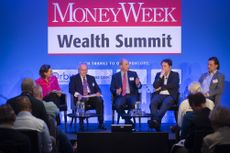You may not have heard of royalty companies, but they’re a great way to invest in gold
Royalty companies provide funding to gold miners in exchange for a share of production revenues. And they have been performing much better than the miners. Dominic Frisby picks the best bets in this little-known sector.


We tend to think there are two means by which to invest in gold. Via the metal – coins, bars, futures and so on – or via a company that mines it. The metal is the safer option, but (assuming it all goes right, which often isn’t the case) you make greater returns with the mining company, though with greater risk.
There is a third way. In terms of risk, it stands somewhere between metal and miner: the royalty company. And this is the option I’d like to consider today.
What is a royalty company anyway?
Let's start by explaining what a royalty company is. Building a mine is extremely expensive. It takes a lot of capital and a lot of time – extraordinary amounts. From exploration, through development and construction, to actual production, can take many years and hundreds of millions, sometimes billions of dollars in capital.
Subscribe to MoneyWeek
Subscribe to MoneyWeek today and get your first six magazine issues absolutely FREE

Sign up to Money Morning
Don't miss the latest investment and personal finances news, market analysis, plus money-saving tips with our free twice-daily newsletter
Don't miss the latest investment and personal finances news, market analysis, plus money-saving tips with our free twice-daily newsletter
The traditional way to finance a mine is through borrowing money or issuing equity. Borrowing the money you need to build a mine can be problematic and restrictive. Cheap debt can be hard to come by, especially in bear markets. Too much debt or delays in its repayment can be destructive. Debt has brought down many a mining company. The other means to finance a mine – issuing shares – has its own set of problems, not least that it can be extremely dilutive to existing shareholders.
Enter the royalty company. In exchange for a share of the mining company’s eventual production – a royalty – the royalty company will provide the funding that the mining company needs. That share of production or royalty might take several different forms. Once the mine is producing, the royalty company might receive a percentage of that production at a pre-determined price – either a set price or at a percentage discount to the gold price. The royalty company can then sell that gold at market rates, and thereby make its profit. This would be a streaming contract. Around 75% of royalty deals are streaming contracts.
Alternatively, the mining company sells its gold directly into the market and then writes the royalty company a cheque for its share of the revenue or profit. This would be a royalty deal. A share of revenue would be an NSR – net smelter return. A share of profit would be an NPI – a net profits interest.
From an investment point of view there are many reasons to like royalty companies. With prices for mining output already set, they can still make money even when the gold price is falling. They don’t operate mines themselves, and so the huge infrastructure and operating costs do not fall to them. They take on lower levels of debt than producers. Their staff costs are low. A mine might employ hundreds of thousands of people, royalty companies have no such burden.
Wheaton Precious Metals (LSE: WPM) is among the largest royalty companies in the world. It is listed in London, New York and Toronto. Its market cap is around US$20bn. It has just two offices and fewer than 40 employees. Its third quarter revenue, announced just yesterday, was US$307m. That works out at an annual rate of over $30m per employee. I wonder if there are many companies in the world that generate that kind of revenue per employee. Even tech companies would struggle.
Royalty companies can pick and choose their projects, so they can avoid dodgy management, jurisdictions or mine economics, if they so choose. They hold diversified portfolios and so minimise the concentration risk you find in a mining company that is dependent on its projects alone, which might amount to just one or two properties. In the event that one property goes wrong, the royalty company has other contracts to fall back on. Some royalty companies will diversify by owning streams on other metals, even on oil.
Royalty companies have done a lot better than miners
I’ve often uttered frustration on these pages that mining companies have so underperformed the metal when they are supposed to outperform it. No such complaint can be made about royalty companies. Though the model is relatively young – human beings may have been mining gold for thousands of years, probably since before the dawn of civilisation, but the first royalty company came into existence in 2004 – royalty companies have outperformed metal and miner in both bull and bear market.
Over the last ten years we have seen both bull and bear markets in gold. Ten years ago gold was $1,350 an ounce, so today it’s trading about 40% higher. The HUI – the index of unhedged gold miners – on the other hand, is about 40% lower. Junior miners, as represented by the VanEck Vectors Junior Gold Miners exchange-traded fund (NYSE: GDXJ), are more than 50% down.
Now let’s look at four of the largest gold royalty companies (chosen for no other reason than that they were the first ones that came to mind) – Franco Nevada (NYSE: FNV), Royal Gold (NYSE: RGLD), Wheaton Precious Metals (NYSE: WPM) and Sandstorm Gold (NYSE: SAND). Franco Nevada is up over 400% since 2010, Royal Gold is up over 150%, Wheaton Precious Metals is up 50% and Sandstorm is up over 100%. Remember that includes the 2012-2016 period, which was one of the most vicious precious metals bear markets ever known to man.
There are many royalties companies to choose from in the space, as well as the above-mentioned large caps. Wheaton Precious Metals has a London listing, but to buy the other large-cap operations you’ll need to venture across the pond (or your broker will). Canada has a plethora of small and mid-caps in the space. Consider Metalla Royalty and Streaming (Vancouver: MTA), Elemental Royalties (Vancoucer: ELE) and Nomad Royalty Company (Toronto: NSR). Of these, at current prices, my favourite is Elemental and, disclaimer, I own shares in that one.
The small cap space in London has a couple of other options, if you prefer this side of the water. Trident Royalties (Aim: TRR) is one – market cap around £30m. I must confess I don’t know the company – I only discovered it while researching this article.
Finally, there’s another company in which I own stock and have mentioned on these pages before: Altus Strategies (Aim: ALS). Altus has projects all across Africa – something like 20 different projects and nine royalties – and is so undervalued as to be verging on the extraordinary. Its Mali projects alone more than justify its current £35m market cap. One day the market will give it the valuation it deserves.
Daylight Robbery – How Tax Shaped The Past And Will Change The Future is now out in paperback at Amazon and all good bookstores with the audiobook, read by Dominic, on Audible and elsewhere.
Dominic Frisby (“mercurially witty” – the Spectator) is the world’s only financial writer and comedian. He is MoneyWeek’s main commentator on gold, commodities, currencies and cryptocurrencies. He is the author of the books Bitcoin: the Future of Money? and Life After The State. He also co-wrote the documentary Four Horsemen, and presents the chat show, Stuff That Interests Me.
His show 2016 Let’s Talk About Tax was a huge hit at the Edinburgh Festival and Penguin Random House have since commissioned him to write a book on the subject – Daylight Robbery – the past, present and future of tax will be published later this year. His 2018 Edinburgh Festival show, Dominic Frisby's Financial Gameshow, won rave reviews. Dominic was educated at St Paul's School, Manchester University and the Webber-Douglas Academy Of Dramatic Art.
You can follow him on Twitter @dominicfrisby
-
 The industry at the heart of global technology
The industry at the heart of global technologyThe semiconductor industry powers key trends such as artificial intelligence, says Rupert Hargreaves
By Rupert Hargreaves Published
-
 What are shareholder voting rights and why do they matter?
What are shareholder voting rights and why do they matter?If you hold shares in a company, the chances are they’ll come with voting rights. But how do you exercise your right to vote? And is your fund manager taking it seriously?
By Katie Williams Published
-
 Halifax: House price slump continues as prices slide for the sixth consecutive month
Halifax: House price slump continues as prices slide for the sixth consecutive monthUK house prices fell again in September as buyers returned, but the slowdown was not as fast as anticipated, latest Halifax data shows. Where are house prices falling the most?
By Kalpana Fitzpatrick Published
-
 Rents hit a record high - but is the opportunity for buy-to-let investors still strong?
Rents hit a record high - but is the opportunity for buy-to-let investors still strong?UK rent prices have hit a record high with the average hitting over £1,200 a month says Rightmove. Are there still opportunities in buy-to-let?
By Marc Shoffman Published
-
 Pension savers turn to gold investments
Pension savers turn to gold investmentsInvestors are racing to buy gold to protect their pensions from a stock market correction and high inflation, experts say
By Ruth Emery Published
-
 Where to find the best returns from student accommodation
Where to find the best returns from student accommodationStudent accommodation can be a lucrative investment if you know where to look.
By Marc Shoffman Published
-
 Best investing apps
Best investing appsWe round up the best investing apps. Looking for an easy-to-use app to help you start investing, keep track of your portfolio or make trades on the go?
By Ruth Emery Last updated
-
 The world’s best bargain stocks
The world’s best bargain stocksSearching for bargain stocks with Alec Cutler of the Orbis Global Balanced Fund, who tells Andrew Van Sickle which sectors are being overlooked.
By Andrew Van Sickle Published
-
 Revealed: the cheapest cities to own a home in Britain
Revealed: the cheapest cities to own a home in BritainNew research reveals the cheapest cities to own a home, taking account of mortgage payments, utility bills and council tax
By Ruth Emery Published
-
 UK recession: How to protect your portfolio
UK recession: How to protect your portfolioAs the UK recession is confirmed, we look at ways to protect your wealth.
By Henry Sandercock Last updated